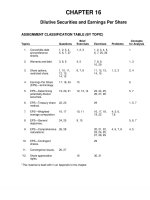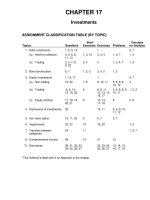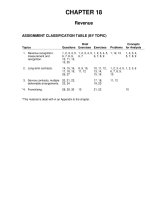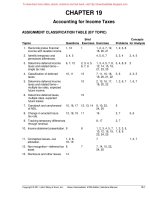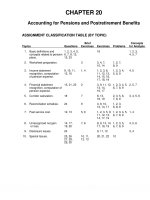Intermediate accounting IFRS 3rd ch18
Bạn đang xem bản rút gọn của tài liệu. Xem và tải ngay bản đầy đủ của tài liệu tại đây (3.45 MB, 158 trang )
Prepared by
Coby Harmon
University of California, Santa Barbara
Westmont College
18-1
CHAPTER 18
Revenue Recognition
LEARNING OBJECTIVES
After studying this chapter, you should be able to:
18-2
1.
Understand the fundamental
concepts related to revenue
recognition and measurement.
3. Apply the five-step process to
major revenue recognition
issues.
2.
Understand and apply the fivestep revenue recognition
process.
4. Describe presentation and
disclosure regarding revenue.
PREVIEW OF CHAPTER 18
Intermediate Accounting
IFRS 3rd Edition
Kieso ● Weygandt ● Warfield
18-3
Fundamentals of
Revenue Recognition
LEARNING OBJECTIVE 1
Understand the fundamental
concepts related to revenue
recognition and measurement.
Background
Both the IASB and the FASB have indicated that the
state of reporting for revenue was unsatisfactory.
Recently, the IASB issued a converged standard on
revenue recognition entitled Revenue from Contracts
with Customers.
18-4
LO 1
Revenue Recognition
New Revenue Recognition Standard
Revenue from Contracts with Customers, adopts an
asset-liability approach.
18-5
Companies account for revenue based on the asset or
liability arising from contracts with customers.
Companies analyze contracts with customers because
contracts initiate revenue transactions.
►
Contracts indicate terms of the transaction,
►
provide the measurement of the consideration, and
►
specify the promises that must be met.
LO 1
New Revenue Recognition Standard
ILLUSTRATION 18.1 Key Concepts of Revenue Recognition
18-6
Performance Obligation is Satisfied
LO 1
Overview of the Five-Step Process
Assume that Airbus (FRA) Corporation signs a contract to sell
airplanes to Cathay Pacific Airlines (HKG) for €100 million.
ILLUSTRATION 18.2
Five Steps of Revenue Recognition
Step 1: Identify the
contract with
customers.
A contract is an agreement between two parties
that creates enforceable rights or obligations. In
this case, Airbus has signed a contract to deliver
airplanes to Cathay Pacific.
Step 2: Identify the
separate performance
obligations in the
contract.
Airbus has only one performance obligation—to
deliver airplanes to Cathay Pacific. If Airbus also
agreed to maintain the planes, a separate
performance obligation is recorded for this
promise.
18-7
LO 1
Overview of the Five-Step Process
ILLUSTRATION 18.2 Five Steps of Revenue Recognition
Step 3: Determine
the transaction
price.
Transaction price is the amount of consideration
that a company expects to receive from a
customer in exchange for transferring a good or
service. In this case, the transaction price is
straightforward—it is €100 million.
Step 4: Allocate the
transaction price to
the separate
performance
obligations.
In this case, Airbus has only one performance
obligation—to deliver airplanes to Cathay Pacific.
18-8
LO 1
Overview of the Five-Step Process
ILLUSTRATION 18.2 Five Steps of Revenue Recognition
Step 5: Recognize
revenue when
each performance
obligation
is satisfied.
18-9
Airbus recognizes revenue of €100 million for the
sale of the airplanes to Cathay Pacific when it
satisfies its performance obligation—the delivery of
the airplanes to Cathay Pacific.
LO 1
Extended Example of Five-Step Process
Identifying the Contract with Customers—Step 1
Assume that Tyler Angler orders a large cup of black coffee costing $3
from BEAN. Tyler gives $3 to a BEAN barista, who pours the coffee
into a large cup and gives it to Tyler.
Question: How much revenue should BEAN recognize on this
transaction?
18-10
LO 1
Extended Example of Five-Step Process
Step 1: Identify the contract with customers.
1. The contract has commercial substance: Tyler gives cash for
the coffee.
2. The parties have approved the contract: Tyler agrees to
purchase the coffee and BEAN agrees to sell it.
3. Identification of the rights of the parties is established: Tyler
has the right to the coffee and BEAN has the right to receive $3.
4. Payment terms are identified: Tyler agrees to pay $3 for the
coffee.
5. It is probable that the consideration will be collected: BEAN
has received $3 before it delivered the coffee.
18-11
It appears that BEAN and Tyler have a valid contract with one another.
LO 1
Extended Example of Five-Step Process
Step 2: Identify the separate performance obligations.
BEAN has a performance obligation to provide a large cup of coffee
to Tyler.
BEAN has no other performance obligation for any other good or
service.
Step 3: Determine the transaction price.
The price of the coffee is $3, and no discounts or other adjustments
are available. Therefore, the transaction price is $3.
18-12
LO 1
Extended Example of Five-Step Process
Step 4: Allocate the transaction price to the separate
performance obligations.
Given that BEAN has only one performance obligation, no allocation
is necessary.
Step 5: Recognize revenue when each performance
obligation is satisfied.
BEAN satisfies its performance obligation when Tyler obtains control
of the coffee.
BEAN should recognize $3 in revenue from this
transaction when Tyler receives the coffee.
18-13
LO 1
Extended Example of Five-Step Process
Identifying Separate Performance Obligations—Step
2
The following day, Tyler orders another large cup of coffee for $3 and
also purchases two bagels at a price of $5. The barista provides these
products and Tyler pays $8.
Question: How much revenue should BEAN recognize on the
purchase of these two items?
18-14
LO 1
Extended Example of Five-Step Process
Step 1: Identify the contract with customers.
A valid contract exists as it meets the five conditions necessary for a
contract to be enforceable as discussed in the previous example.
Step 2: Identify the separate performance obligations.
BEAN must determine whether the sale of the coffee and the sale of
the two bagels involve one or two performance obligations.
18-15
LO 1
Extended Example of Five-Step Process
Step 2: Identify the separate performance obligations.
Multiple performance obligations exist when the following two
conditions are satisfied:
1.
BEAN must provide a distinct product or service.
2.
BEAN’s products are distinct within the contract. If the performance
obligation is
►
not highly dependent on,
►
or interrelated with,
other promises in the contract, then each performance obligation
should be accounted for separately.
BEAN has two performance obligations.
18-16
LO 1
Extended Example of Five-Step Process
Step 3: Determine the transaction price.
The transaction price is $8 ($3 + $5).
Step 4: Allocate the transaction price to the separate
performance obligations.
BEAN has two performance obligations.
18-17
►
Each obligation is distinct and not interrelated (and priced
separately); no allocation of the transaction price is necessary.
►
The coffee sale is recorded at $3 and the sale of the bagels is
priced at $5.
LO 1
Extended Example of Five-Step Process
Step 5: Recognize revenue when each performance
obligation is satisfied.
BEAN has satisfied both performance obligations when the coffee
and bagels are given to Tyler (control of the product has passed to
the customer).
BEAN should recognize $8 ($3 + $5) of revenue
when Tyler receives the coffee and bagels.
18-18
LO 1
Extended Example of Five-Step Process
Determining the Transaction Price—Step 3
BEAN is interested in stimulating sales of its Smoke Jumper coffee
beans on Tuesdays, a slow business day for the store. Normally,
these beans sell for $10 for a 12-ounce bag, but BEAN decides to cut
the price by $1 when customers buy them on Tuesdays (the
discounted price is now $9 per bag). Tyler has come to the store on a
Tuesday, decides to purchase a bag of Smoke Jumper beans, and
pays BEAN $9.
Question: How much revenue should BEAN recognize on this
transaction?
18-19
LO 1
Extended Example of Five-Step Process
Step 1: Identify the contract with customers.
A valid contract exists as it meets the five conditions necessary for a
contract to be enforceable as discussed in the previous example.
Step 2: Identify the separate performance obligations.
BEAN has a performance obligation to provide a bag of Smoke
Jumper coffee beans to Tyler.
BEAN has no other performance obligation to provide a product or
service.
18-20
LO 1
Step 3: Determine the transaction price.
The transaction for a bag of Smoke Jumper beans sold to Tyler is
$9, not $10.
Step 4: Allocate the transaction price to the separate
performance obligations.
There is only one performance obligation, no allocation is necessary.
Step 5: Recognize revenue when each performance
obligation is satisfied.
BEAN has satisfied both performance obligations.
BEAN should recognize $9 of revenue when Tyler receives
the Smoke Jumper coffee beans.
18-21
LO 1
Extended Example of Five-Step Process
Allocating the Transaction Price to Separate
Performance Obligations—Step 4
Transaction price is allocated to the various performance obligations
based on their relative standalone selling prices.
BEAN offers customers a $2 discount on the purchase of a large cup
of coffee when they buy a bag of its premium Motor Moka beans
(which normally sell for $12) at the same time. As indicated earlier, a
large cup of coffee normally retails for $3 at BEAN.
Question: How much revenue should BEAN recognize on the
purchase of these two items?
18-22
LO 1
Extended Example of Five-Step Process
Step 1: Identify the contract with customers.
A valid contract exists as it meets the five conditions necessary for a
contract to be enforceable as discussed in the previous example.
Step 2: Identify the separate performance obligations.
The bag of Motor Moka beans and the large cup of coffee are
distinct from one another and are not highly dependent on or highly
interrelated with the other.
18-23
LO 1
Extended Example of Five-Step Process
Step 3: Determine the transaction price.
The transaction price is $13 ($12 + $1).
Step 4: Allocate the transaction price to the separate
performance obligations.
BEAN allocates the transaction price to the two performance
obligations based on their relative standalone selling prices as
follows.
18-24
LO 1
Extended Example of Five-Step Process
Step 4: Allocate the transaction price to the separate
performance obligations.
BEAN allocates the transaction price to the two performance
obligations based on their relative standalone selling prices as
follows.
The total transaction price ($13) is allocated $10.40 to the bag of
Motor Moka beans and $2.60 to the large cup of coffee.
18-25
LO 1





